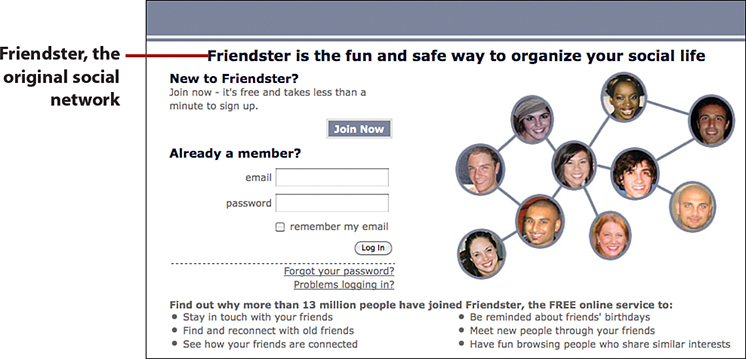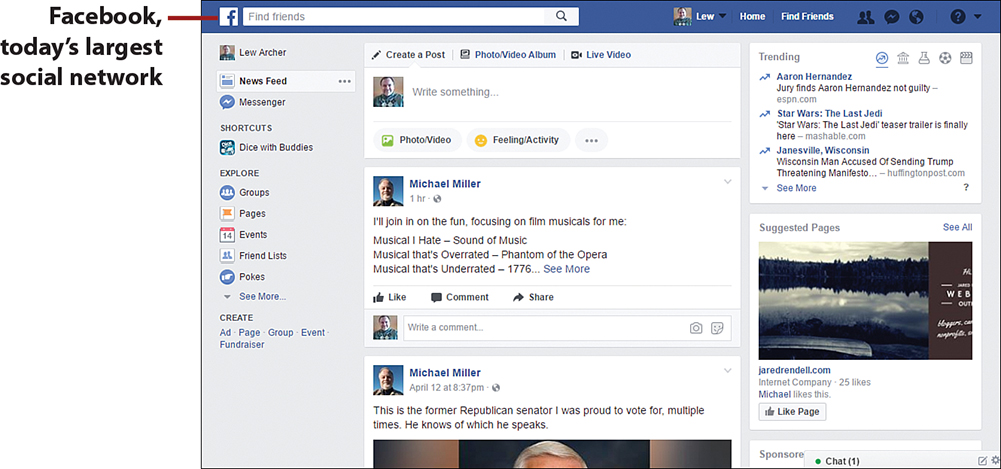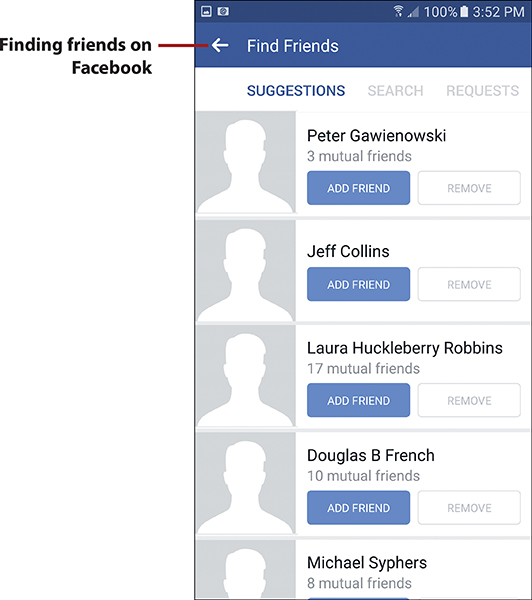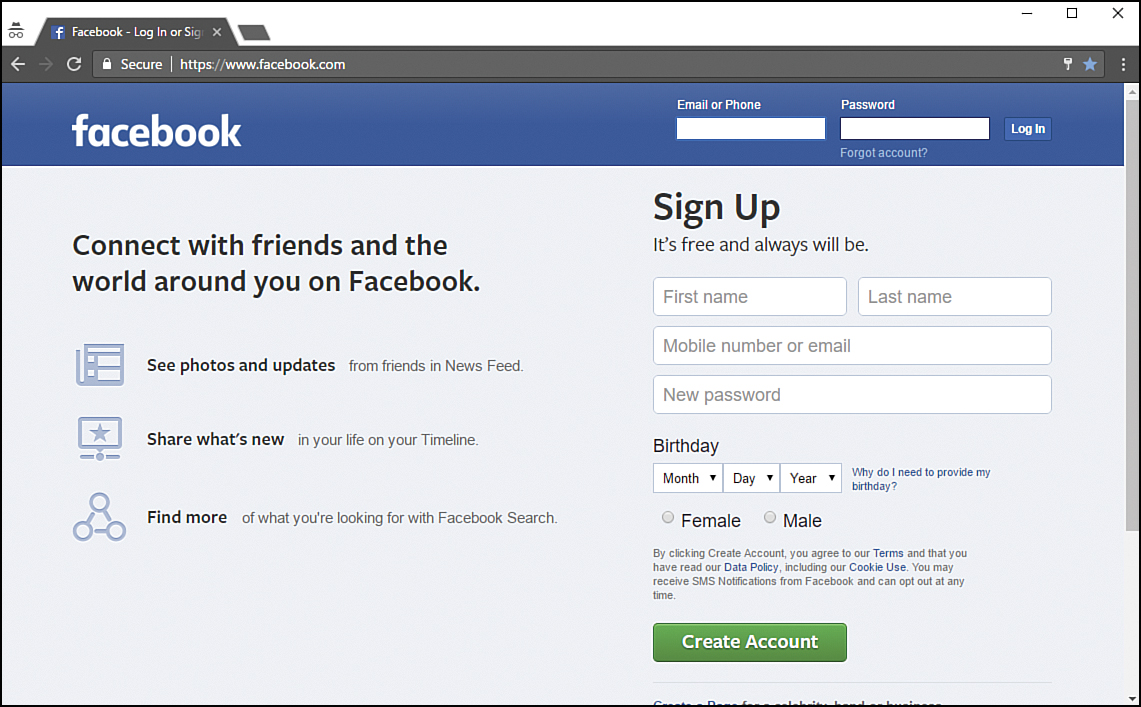1. What Social Media Is—and Why We Use It
In this chapter, you learn all about social media—what it is, how it works, and why you might want to use it.
You’ve heard people talking about this thing called social media. Chances are, some of your friends, family, and colleagues use Facebook, LinkedIn, Pinterest, Twitter, or some similar site. You might even have your own Facebook account, even if you don’t use it much.
The term social media might sound complicated or technical or even a little confusing. Don’t worry; it isn’t. In reality, social media—such as Facebook, LinkedIn, Pinterest, and Twitter—help you connect with your family, friends, and colleagues. It’s a new way to communicate with people you know and people you might like to know. And it’s all done on your computer or smartphone or tablet, over the Internet.
Understanding Social Media
What exactly is—or is it are?—social media? There are lots of different definitions, but they all hinge on that one word: social.
Defining Social Media
Merriam-Webster defines social media as “forms of electronic communication... through which users create online communities to share information, ideas, personal messages, and other content....”
That’s pretty technical. I like to think of social media as websites, apps, and services that host a community of users and make it easy for those users to communicate with one another using their computers, smartphones, or tablets. That communication can involve sharing messages and information, as well as pictures and videos. It’s all about being social and encouraging social interactions.
In most instances, these social interactions come in the form of posts or status updates, which are short messages that are posted for public viewing by all of that person’s friends on the site.

A social media post can be a text-only message or one that includes photographs, videos, and links to other web pages. Whatever form the media takes, it’s all about sharing things—socially.
What some people call social media others call social networks. Both names refer to the same thing. That is, a social network is social media, and vice versa. So don’t get hung up on the name.
Understanding How Social Media Works
For most people, social media is all about communicating and staying in touch with one another. It’s the twenty-first-century way to let people know what you’re up to—and to find out what everyone else is up to as well.
Of course, people were communicating and sharing things long before we ever heard of the Internet. We just used different media than we use today.
In the old, old days, the only way you found out what was going on was when someone wrote you a letter. That probably sounds quaint today, as letter writing is somewhat out of fashion. But I’m guessing you’re old enough to have written a few letters in your time, so you know what I’m talking about.
Ah, the joys of receiving a letter from an old friend! I miss seeing a friend’s address in the top-left corner, opening the envelope, and savoring the words within. Of course, most friends didn’t write that often; writing was a lot of work, so you saved up your thoughts and experiences until you had a full letter’s worth. But, man, it was great to read what your friends had been doing. It almost made the wait worthwhile.
That was then, and this is now. Today, nobody has the time or the patience or the attention span to write or read long letters. At some point back in the 1990s, email replaced the written letter as our primary means of correspondence. That wasn’t necessarily a bad thing; emails were shorter than written letters, but you got them immediately—and you could respond to them immediately, too. With the Internet age came this faster and more direct form of communication, and we adapted to it.
For younger people today, however, email is old hat. It’s too slow and takes too much time. (They’d never have tolerated the age of the written letter...) Instead, most people nowadays prefer immediate communication, primarily (if not exclusively) via text messages on their phones and mobile devices.
The problem with text messages is that they’re not centralized. If you’re texting with a dozen friends, that’s a dozen different “feeds” of information you have to keep track of. There’s no central repository where you can read all your friends’ messages in one place.
This is where social media comes in. Instead of writing a dozen (or a hundred) different letters or emails or texts to each of your friends telling them that you just bought a new dress (or car or house or whatever), you write a single post that those dozen (or hundred) different people can then read. Something happens, you write about it, it gets posted on the social networking site, and everyone you know can read about it. It takes all the work out of keeping your friends up to date on what you’re doing.
Of course, it works in the other direction, too. Instead of waiting for letters or emails or text messages from each of your friends, you just log onto your friendly local social media site. There you find a feed of updates from everyone you know. Read the feed and you’re instantly updated on what everyone is up to. That makes it really easy to keep in touch.
Now, social media lets you do a lot more than just exchange status updates, but that’s the most common activity and the reason most of us do the social media thing. Communications to and from all your friends, all in one place, all done from your personal computer or smartphone or tablet. It’s like communications central for everyone you know—close friends or otherwise.
Building Social Communities
When you share your thoughts and interests via social media, you help to create online communities. To help facilitate this community building, many social media networks let you do more than exchange simple status updates. Depending on the social network, you might find some or all of the following features:
• Private communications. This can take the form of one-to-one private messaging, proprietary email service, and even live text messaging.
• Video chat. This is true face-to-face communications, in real time—assuming both parties have cameras on their personal computers, tablets, or smartphones, of course.
• Groups and forums. These are like online clubs built around specific areas of interest. You can find groups for hobbies like woodworking or quilting, for topics like politics or sports, and for just about anything else you can think of. There are even groups devoted to specific companies, schools, and entertainers. (Groups for entertainers are more like fan clubs than anything else.)
• Photo and video sharing. That’s right, many social networks let you upload your pictures and movies and share them with all your friends on the network. It’s the twenty-first-century way of sharing your photos—no slides or prints necessary.
There’s a bit more than even all this, including event scheduling and the like, but you get the general idea. Social media are online communities and offer many of the same activities that you’d find in real-world communities.
A Short History of Social Media
The social media that we know today have been around for only about a decade—although their core features have existed since the earliest days of the Internet.
If you’re old enough to remember the earliest personal computers back in the 1970s and 1980s, you may remember pre-Internet communications in the form of dial-up computer networks (such as America Online, CompuServe, and Prodigy), bulletin board systems (BBSs), and other simple online discussion forums. Well, these early online services served much the same function as do today’s social media, offering topic-based discussion forums and chat rooms, just like Facebook and LinkedIn do today. What they didn’t offer was a way to follow friends on the site, or to publicly share status updates. But the seeds of today’s social media were there.
Other components of modern social media developed after the rise of the public Internet and the World Wide Web. For example, numerous topic-based website communities, such as Classmates.com, Epicurious, and iVillage, arose in the mid-1990s. Personal blogs, which let users post short articles of information and opinion, emerged around the year 2000. And photo-sharing sites, such as Flickr and Photobucket, became a part of the Internet landscape in the early 2000s.
The first service to combine all of these features into a single social network was Friendster, in 2002. Friendster also introduced the concepts of “friends” and “friending” to the social web; it all came from the name, not surprisingly.

Friendster enjoyed immediate popularity (more than 3 million users within the first few months of operations), but ran into technical problems associated with that growth and was soon surpassed by MySpace, which launched the next year. MySpace became the Web’s most popular social network in June 2006, and remained so for almost two years.
Friendster and MySpace were part of the first wave of social media. The second wave formed in 2004, when a site originally known as “thefacebook” came on the scene. What eventually became known as just “Facebook” was originally launched as a site where college students could socialize online, but it quickly opened its doors for users of all ages.
The Social Network
The story of Facebook’s genesis was told in the 2010 film, The Social Network. Although some elements of the film are clearly fictitious, it’s actually a fairly accurate retelling of events.
The broadening in Facebook’s user base led to a huge increase in both users and usage, with Facebook surpassing MySpace in April 2008. Today, Facebook is not only the number-one social network, it’s also the number-two site on the entire Internet, with more than 1 billion users of all ages. That’s a pretty big deal.

Facebook isn’t the only social network today, however. Hot on its heels are several social media that are more specialized than the general-interest Facebook. These newer contenders include Twitter (specializing in short text-only messages), Pinterest (which lets users share images they find all across the Web), LinkedIn (targeting business professionals), and Instagram (which is all about photo sharing). None of these social media is near as big as Facebook, but they serve different needs.
Who Uses Social Media—and Why
With all that social media have to offer, it’s not surprising that so many people use them day in and day out. As with many new technologies, social media started out being used almost exclusively by high school and college students. (That’s how the Internet itself took off, after all.) But over time, social media spread from the young generation to the general public, including older users like you and me.
While different social media appeal to different groups of users, the audience for social media in general has evolved into something approximating that of the general population—which means that more and more older people are getting social. Taking Facebook as an example, 72% of those aged 50 to 64 use Facebook, as do 62% of all Internet users aged 65 and older. (These statistics come from the Pew Internet and American Life Project for the year 2016.)
Differing Popularity
Of course, not all social media are as popular with older users. Twitter, for example, is used by just 10% of Internet users aged 65 and older, and by 21% of those aged 50 to 64. (In contrast, 36% of those aged 18 to 29 use Twitter.)
In practice, then, social media such as Facebook appeal to all sorts of people who have all sorts of reasons for using the media:
• Friends and family members who want to keep in touch
• People looking for long-lost friends
• Business colleagues looking for collaboration and networking
• Singles who want to meet and match up with other singles
• Hobbyists looking for others who share their interests
• Classmates who need study partners and homework advice
• Musicians, actors, and celebrities (and politicians!) connecting with their fans
What all these types of users have in common is that they desire easy and immediate interaction with friends, family members, co-workers, and followers. With social media, it’s easy to interact with other people via public posts, private communication, event calendars, and even community-based games and applications.
In short, the various social media available today help you keep in contact with large numbers of people without having to interact personally with each and every individual. It’s effective and efficient communication.
>>>Go Further: Demographic Migration
I find it interesting that so many technologies are first adopted by younger users, but then use of the technologies eventually migrates upward and outward to older folks and the general population. That’s how it happened not just with social media but also with other Internet-based technologies.
Take email, for instance. Email first became a thing back in the early 1990s, when students on college campuses got used to sending private messages to their friends over their schools’ private email systems. They didn’t want to give up their email when they graduated, which led them to seek out primitive email systems in the real world, including those connected to America Online and other commercial online services. This commercialization of email not only encouraged Hotmail and other companies to get into the email business but also nudged many large and small businesses to adopt email for their own intraoffice communications. Before you knew it, it wasn’t just the college kids using email anymore; everybody, regardless of age, had their own email address. It migrated upward from the kiddies to the adults.
It’s been the same thing with social media. Friendster and MySpace had particular appeal to high school and college students, and Facebook was born on a college campus exclusively for the use of college students. It didn’t take long, however, for these younger users to move out into the real world and take their love for (and reliance on) social media to a larger audience. Soon the twentysomethings became thirtysomethings, who communicated with fortysomethings, who dragged their fifty- and sixtysomething friends and relatives along for the ride. What started as a fun diversion for the younger generation became a useful means of sharing (and a fun diversion, too) for older generations.
So if you want to know what you and your friends will be using next, look to the high school and college kids. What they use today, we’ll probably be using tomorrow.
Why You’ll Want to Use Social Media
Where many younger users tend to sign in to a social network when they wake up in the morning and not sign out until they go to bed at night, older users tend not to be as obsessed with social media. We might check into Facebook or Pinterest a few times a day, but they don’t monopolize our lives. Or at least they shouldn’t.
Instead, those of us aged 50 and up tend to use social media on a more occasional basis to keep tabs on what friends, family members, and colleagues are up to. We are not typically as addicted to social media as our children and grandchildren are; we don’t have to know what everyone is doing on a minute-by-minute basis. Instead, we can log in once or maybe twice a day and get the general drift of everyone’s activities. That’s enough information for most of us.
Grown-ups also use social media to reconnect with people we haven’t seen in a while. A long while, sometimes. Personally, I use Facebook to hook up with old friends from high school and college, and to reconnect with former colleagues and those I might want to work with again. (I guarantee you’ll find people on Facebook and other social media that you haven’t thought about for a long time—which might not always be a good thing, I suppose.)

Social media is also a great way for family members—especially extended families—to keep abreast of comings and goings. It might take a lot of effort to personally write your cousins and aunts and uncles and nieces and nephews and stepchildren and in-laws and all the rest, but a single Facebook status update will do the job of multiple letters and emails. You can also use social media to share family photos with the rest of your family, which is a ton easier than printing and mailing photos manually.
Speaking of family members, social media is also great for keeping in touch with what your children and grandchildren are up to, without them actually having to have a conversation with you about it. All you have to do is add your kids to your social media friends lists, and you’ll see all the posts they make public. (That’s unless they adjust their privacy settings to exclude you from their most private thoughts, which if they’re smart, they’ll do.)
Of course, there are plenty of ways for adult users to waste time on social media, just as our kids do. I know a fair number of supposed grown-ups who get addicted to Candy Crush Saga and other social games, and spend way too much time playing them. Useless social media activity isn’t the sole province of the young; us more mature users can also spend hours doing essentially nothing useful online.
Bottom line, those of us 50 and up use social media for many of the same reasons that younger folks do, but we use it in a smarter and less intrusive fashion. Or so we’d like to think, anyway.

